The complete guide to visitor management systems in 2022
What is a visitor management system?
This guide will show you how can you replace that visitor sign-in sheet with a complete digital visitor management system.
Condeco and iOffice + SpaceIQ Merge to Create Eptura™, the Leading Worktech Software Solution - Learn more.
What is a visitor management system?
This guide will show you how can you replace that visitor sign-in sheet with a complete digital visitor management system.
This guide will demonstrate how it is both simple and beneficial to replace that pen-and-paper visitor sign-in log with a complete digital visitor management system.
Now, in 2021, the bar has been raised for visitor management on corporate premises.
Aside from brand image and immersion through streamlined front desk operations, the stakes around security and compliance standards are higher than ever.
With that in mind, we've updated our guide to reflect the implications of millions of visitors and contractors entering offices and production sites around the world every day.
For organizations both big and small, this uptick in foot traffic means exposure to potential security threats to your employees, production lines, and intellectual property, not to mention health concerns brought on by the global pandemic.
That's why it's crucial to have an enterprise visitor management system in your corner.
Here's what we'll cover:
Visitor management is the act of tracking the people who come and go from your premises.
Whether or not your company has receptionists or even a front desk in place, you should consider visitor management a golden opportunity to raise your brand awareness.
For example: If your organization is known for outstanding customer service and innovation, then the last thing your visitor would expect is to sign in on a piece of paper in your lobby.
It's less about "managing" visitors and more about having them walk away with a good impression of your business. People management: because business meetings are people meetings.
It's a chance for you to align the way you welcome visitors into your building, with your company values.
On any given business day, your visitors can be categorized but not limited to:
During the global health crisis, the safest policy to adopt may be one in which everyone is a visitor.
This includes not only the categories of individuals mentioned above but also regular employees - particularly given that the same people may not be showing up at the office every day due to work-from-home and hybrid work situations.
In order to maintain safe social distancing, align with healthcare experts’ recommended best practices, and make sure everyone has a place to work, many companies are finding it useful to view their own employees as frequent visitors - and make sure their presence on the premises is accounted for accordingly.
Regardless, a company dictates what types of visitors are expected - and that will vary tremendously based on their needs.
If you're reading this, then you've probably attended a meeting or two at someone else's place of business. Or maybe you've been job hunting recently, and have been in an out of your share of corporate lobbies.
Hopefully, you have fond memories of those visits—how you were greeted, made to feel safe and welcomed during your stay, as a part of doing business.
Chances are, there was a system in place to make your experience for visitors such a positive one.
A visitor management system represents all the processes and activities an organization puts in place to manage the flow of visitors, from start to finish, as a part of the bigger picture—the visitor experience
The term "visitor experience" is used most often in the business-to-consumer (B2C) world.
It refers to clients’ experiences involving anything from a trip to the movie theater, to purchasing a new couch in a furniture store, to signing up with a bank and opening a checking account - and encompasses all the customers’ feelings and impressions about these events.
But in this era of digital transformation, it's more important than ever that there's a human touch - a focus on individual visitor experience, and on satisfying a client - in the B2B world.
Companies consist of people, and business-to-business settings also present stages for experiences.
— Pine & Gilmore in 'Welcome to the Experience Economy,' Harvard Business Review
The Harvard Business Review published Welcome to the Experience Economy more than 20 years ago, but the messages still ring true today. And they can be applied to your organization's visitor management.
It's high-time the visitor experience sees some changes, because "the conventional approach" isn't working anymore.
An archaic visitor management system, aka the paper sign-in sheet, results in a poor experience for our friendly visitor "Steven":
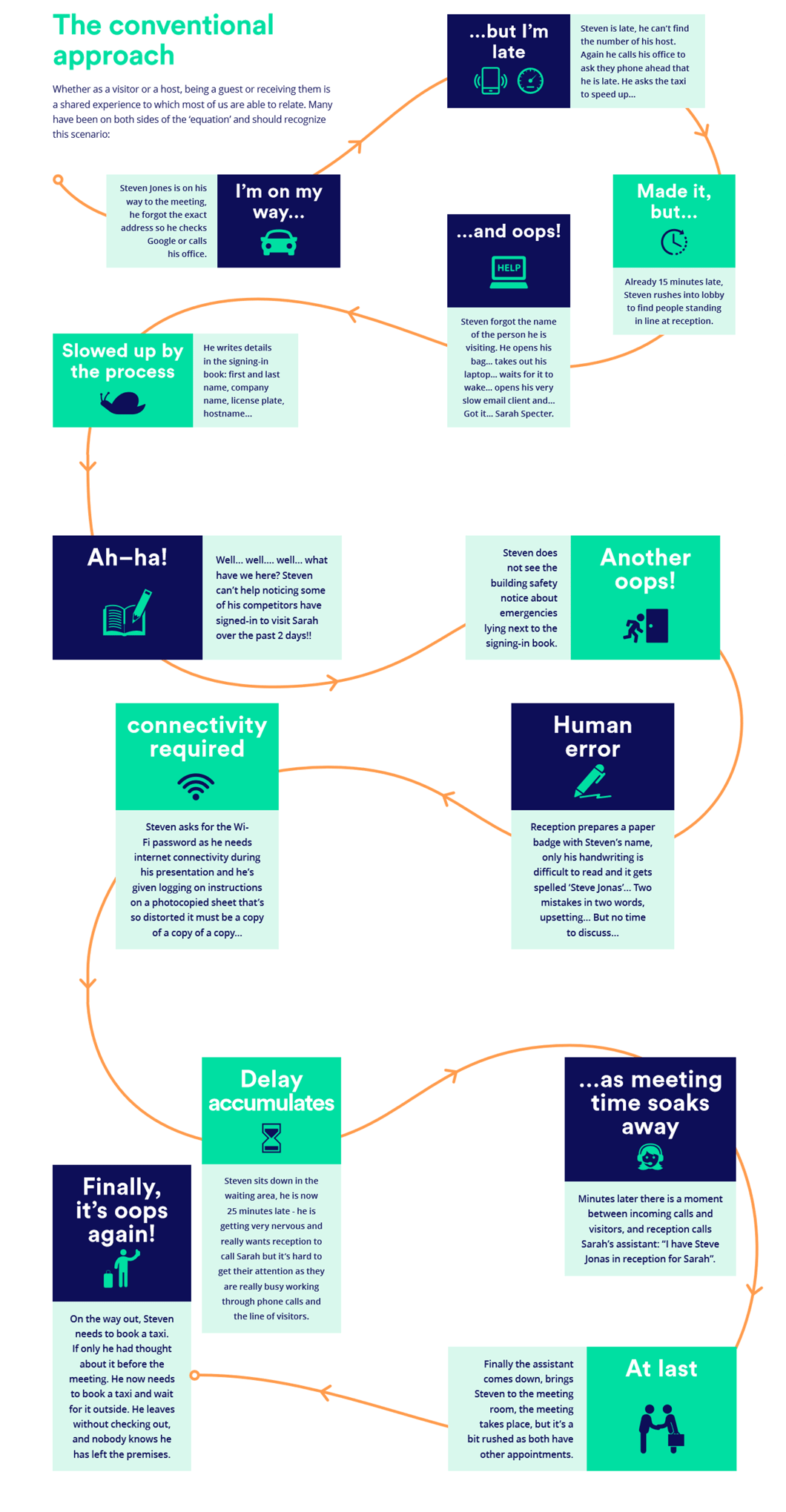
If only his hosts had chosen a better visitor management system than old-fashioned pen and
Would you believe us if we told you that Steven could have been saved from all his pain and misery?
Download Steven's improved path so you can see how you can do better for your visitors today.
There's a common misconception that "visitor management systems are expensive and only for big companies."
Size does not matter when it comes to visitor management. Organizations both great and small, to Fortune 500 and Fortune 50, can benefit from a solid visitor management system.
There exist solid use cases already, both on global and local levels:
Visitor management systems are used across industries as well, from A to almost-Z (until we get our first Proxyclick-using Zoo, maybe).
During the COVID-19 pandemic, more and more essential industries have been turning to visitor management systems to help them adapt safely to the challenges of keeping their workforce safe while continuing to deliver products and services that are, in some cases, even more in demand.
These include manufacturing companies, data centers, pharmaceutical companies, food production and packaging, chemical companies, and logistics companies.
For all of these industries, visitor management systems have been instrumental in helping them to return their employees to work with a higher level of safety, facilitating services such as:
We know that there's no one-size-fits-all solution. It's important to choose a visitor management provider that can scale—up or down—with your company.
Internet technology has progressed by leaps and bounds within the first two decades of the 21st century, at a faster rate than over the previous 50 years.
Though the role of the receptionist has evolved dramatically from the outdated archetypes depicted in television shows like AMC's Mad Men, some companies persist in utilizing pen and paper as a default visitor management system.



The infamous paper logbook—what seems like an innocent enough and low-cost VMS can cost you more in the long run.
You'll be able to record basic information about your visitors and hope that they've given their real names and such. But that's if you can read their handwriting in the first place.
But from an efficiency and security standpoint, you're asking for trouble if you depend on the paper logbook.
Not only do visitor
The easy visibility and availability of visitors’ information are one of the many problems with the paper logbook system, in that it’s all too easy for someone with ill intent to capture that data (say, by taking a screenshot on a phone when no one is looking.)
But, data privacy and security issues are not the only downside of the paper logbook; there’s also the fundamental inability to use that data productively, as far as keeping workers safe or ensuring a smooth visitor experience (as you’ll learn more about later in this guide.)
Friends shouldn't let friends use old legacy software for their visitor management either.
Granted, moving away from the paper trail and onto the electronic logbook is a step in the right direction. But do you really want to deal with the amortized costs of legacy systems?
With on-site software options, you'll run into a number of obstacles:
Why refresh servers and burden your balance sheet when you can get them as a service?
— Jacek Materna in 'On-Premise Is Dead, Long Live On-Premise,' Forbes
Forbes Technology Council member Jacek Materna is absolutely right.
Besides—knock on wood—in the event of emergency or evacuation, that "electronic sign in sheet" stored on a hard drive inside your office isn't going to be nearly as much help to you as a cloud-based visitor management system. (More on that in a moment.)
The interface is connected to the cloud where the information the visitors enter is gathered and then presented - on the other side of the front desk - in a dashboard for easy management.
Moreover, a cloud-based system integrates with other platforms, to avoid a complicated overhaul of existing architecture (and a slew of common problems with the adoption of new technology).
Only a cloud-based SaaS solution can provide you a best-of-breed approach so you have more control over what you're using and what you're paying for.
You don't even have to take our word for it.
This movement also holds true for that of the cloud-based visitor management system.
Your visitor management system should be able to make your life easier in a number of ways. And let's face it, the cloud doesn't sleep or take bathroom breaks. It doesn't need cooling or storing in some server room in your building. Nowadays, you can try cloud applications for free before you ever put any money down.
We've got four really good and timely reasons right of the top of our heads to share with you.
They're actually statistics pulled from 2,000 working professionals who were polled in the Front Desk Experience Survey 2018.
And they only scratch the surface of what office workers across the US and the UK had to say about their experiences in corporate lobbies. (Download the report)
But they do provide some compelling reasons to consider a visitor management system:

Even in this era of video conferencing and live webinars, there is no end to live face-to-face business meetings in sight.
This goes for both the US and the UK.
You will never see eye-to-eye if you never meet face-to-face.
— Warren Buffett, Chairman and CEO of Berkshire Hathaway
According to numbers reported in Meetings in America: A study of trends, costs, and attitudes..., there are an estimated 11 million face-to-face business meetings happening across the US every day.
At first, the number sounds unbelievable, but when you consider the population of America runs upwards of 320 million then it makes sense.
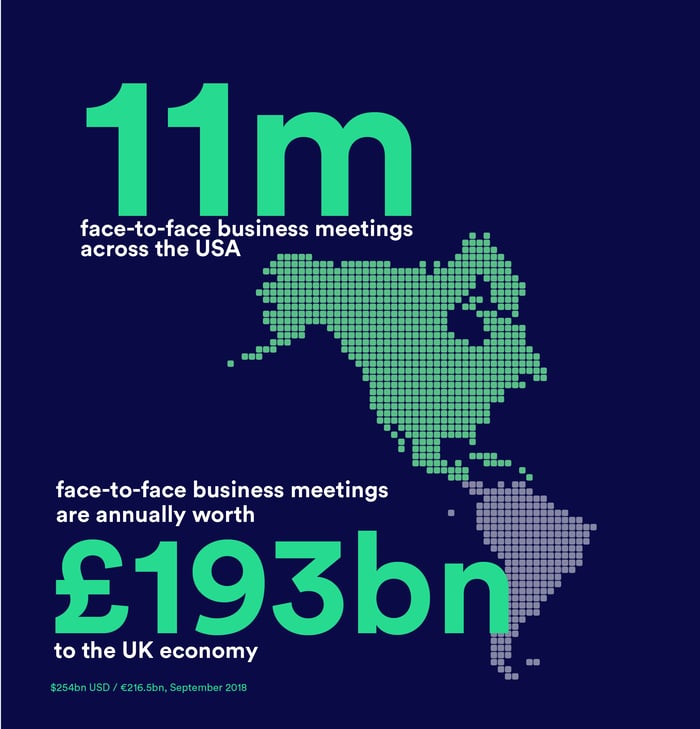
Similarly, a 2016 survey commissioned by that Centre for Economics and Business Research reports that face-to-face business meetings account for £193Bn of the UK economy.
In addition, London-based companies especially are primed to gain approximately £250K in new business simply by holding in-person business meetings.
So why wouldn't you (and your organization) take visitor management seriously? Let's take a closer look at the aforementioned four reasons.
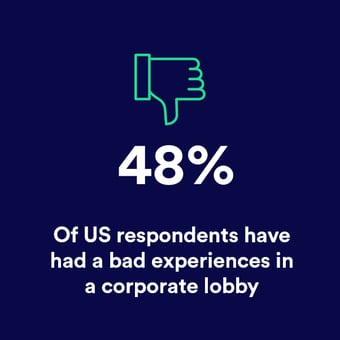
With 48% of US respondents admitting to having bad experiences in corporate lobbies, we can deduce that these were bad first impressions made off the bat.
We even took a deeper look at the 8 main reasons cited for the poor visitor experiences in the reception area:
It's such a shame because most bad experiences in corporate lobbies can be avoided with the right amount of preparation and automation.
Each of the complaints in the graphic above should be viewed, instead, as a chance to implement best practices - and that can be accomplished by utilizing the right visitor management system.
(Pro tip: never underestimate the power of an invitation email in setting the tone and professionalism from day one.)
Can you see the potential for best practices in each of the complaints above? Every one of them could be remedied by the right visitor management system.
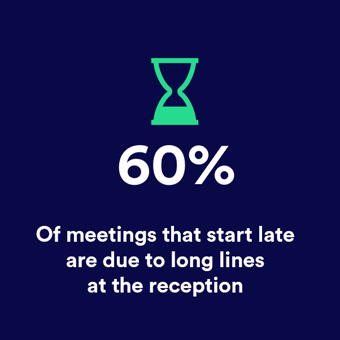
Business meetings are people meetings, and in-person meetings are not going anywhere. So why are "long lines at reception" to blame 60% of the time?
The 2018 Front Desk Experience Survey also revealed three other obstacles.
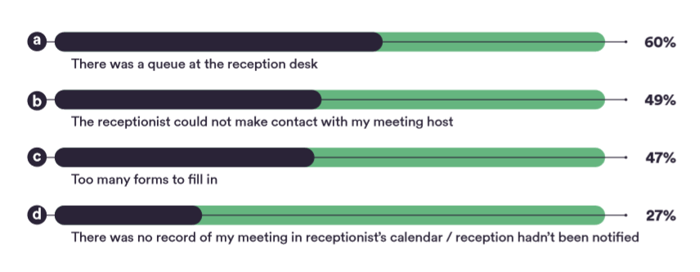
Independent of other research, Joseph Allen, at the University of Nebraska Omaha, surveyed professionals across a variety of industries in the US: sales, retail, media, construction, IT, etc.
Allen and his team asked these volunteers about the last meeting they'd attended, and his team published their findings in "Let's get this meeting started: Meeting lateness and actual meeting outcomes."
In it, they reveal that 40–50% of the meetings started late. Period.
That margin of lateness borders on destruction, and certainly indicates wastes of time that a visitor management system could have salvaged.
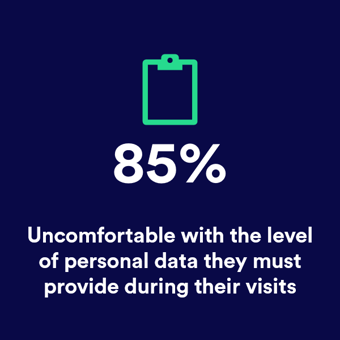
We get it. There's a fine line between keeping your office building secure and making your visitors uncomfortable.
But there's no need to make 85% of your visitors feel weird about the level of personal data you're asking of them.
Did you know that you can only collect data for required security protocol or to fulfill a business contract?
Data privacy laws, like GDPR, require something called data minimization.
Personal data must be adequate, relevant and limited to what is necessary in relation to the purposes for which they are processed.
— GDPR, Article 5, 1(c)
This should be engrained in the way you do business and a part of your GDPR compliance checklist.
But that's not all.
You have to consider the real risks and imminent threats that start at your front desk.
When it comes to the physical security of your workplace, workforce, and intellectual property, your visitor management system can serve as your first line of defense.
For example: Maintaining high levels of security can be made easier with access and integrations with global watchlists and facial recognition capabilities for verifying ID documentation.
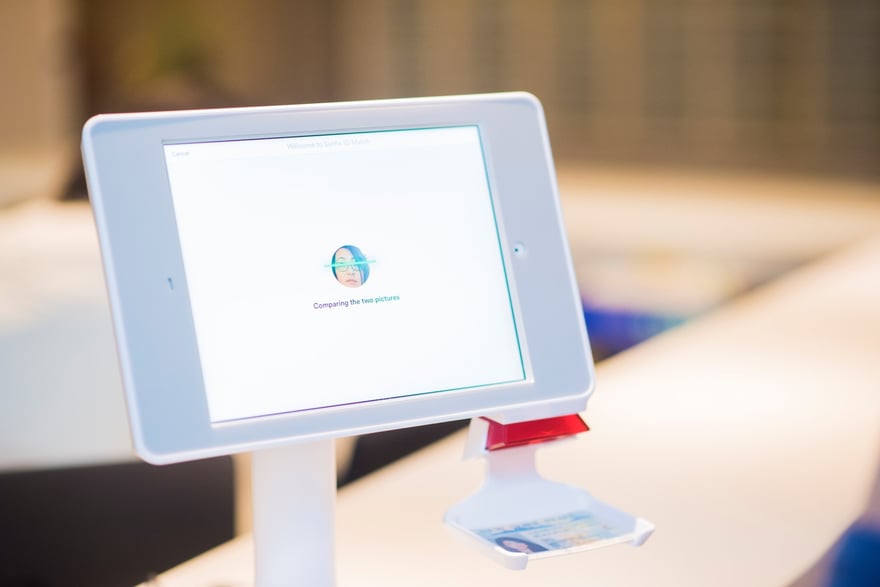
Proxyclick visitor management system with ID Match (ID Scan)
Nobody likes to have features thrown in their face when searching for digital solutions on the internet. However, being tasked with finding the perfect visitor management system for your business means you've got to be thorough.
Does the solution you're looking for check off all the boxes on your list of items for security protocol?
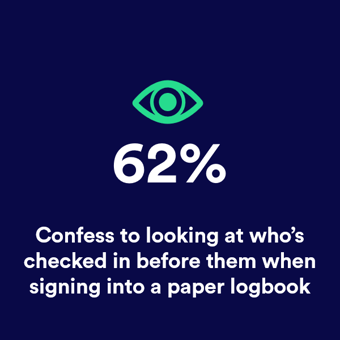
If somewhere between 62% and 70% of your visitors are admitting to sneaking peeks at other people's personal information in the guest registry, then that's a huge red flag you can't ignore.
And according to the survey results, the percentage of confessions to "snooping" was higher for US respondents: 70% to be exact.
When it comes to regulatory compliance audits, your visitor management system will—by default— be the first thing the auditor will "see."
Now, it is possible to procure "discreet sheets" that use blackened bars for carbon copy records—for confidential sign-ins—but still begs the question of data retention and GDPR's Article 7(3).
If you haven't yet been able to wrap your head around all the business requirements around visitor management data and GDPR, then no worries.
We recommend you start with "The simple guide to GDPR and visitor management" and go from there.
Incidentally, the majority of respondents to the 2018 Front Desk Experience Survey voiced their willingness to check in using iPads over the old pen and paper system.
.png?width=404&name=Screenshot%20(500).png)
Everyone's well on their way to a digital future across generations. People, young and old, have been checking in via cloud-based visitor management software for years now.
Isn't time to join the movement before you're left behind with paper cuts?
Prior to the pandemic, many companies already were relying on visitor management systems to allow them to be prepared for a health or safety crisis - be it severe flu outbreak, a heightened security risk of terrorist activity, or other types of unprecedented events.
Solutions that have already been in place, such as:
These have all helped businesses to continue operating safely in situations that might otherwise put their visitors or employees at risk.
Now, these same solutions have become integral parts of both business continuity planning and day-to-day operation during the pandemic: Cloud-based front desk solutions, for instance, remove risks caused by in-person interactions at visitor check-in, as well as creating better, more secure logs of visitor information.
Systems for visitor access control help ensure that employees, visitors, and contractors are able to get quickly and safely to their destinations.
These solutions also help everyone to remain touch-free (not to mention providing a valuable security check so that strangers are not wandering in unauthorized areas, which was the basis of their popularity prior to the pandemic.)
If you've made it to this part of the guide, then it means you're ready to start the research phase into the things to look for when choosing a visitor management system.
So, it's always a good idea to start with a little homework and determine how to align your needs with your visitors' needs.
Really, take a minute and give this some thought.
It's the seamless visitor experience that matters. The way your business is perceived is directly correlated to the way your visitors are welcomed.
Consider this an opportunity to see your visitors in a new way by "re-thinking your reception area."
To get you started, we asked international corporate hospitality experts for their 10 key recommendations:
Great list, isn't it? Would you like to know more?
Well, you can download all the best practices and actionable steps to step up your reception area before you take a minute to assess the kinds of visitors you receive on a regular basis.
If you haven't already, then check out the list of different types of visitors, in Section 1.2 of this guide, before answering the following questions:
Don't limit yourself to the questions listed above.
Brainstorming with key members of your team is also recommended, especially with those who will be benefiting most from a digital visitor management solution.
Write down as much as you can and as much you know about your visitors, past and present and future, and refer to it regularly while you conduct your research.
Then, ask yourself some questions around your business needs:
Having as much information handy will not only help you to better assess your needs, but it will also help you with the process of elimination—that is, choosing which visitor management systems make the cut (after reading their reviews on Google, G2 Crowd, or Capterra) before you give them a try.
Tip: Any visitor management system worth a try will be able to offer you a free trial with no strings attached (i.e. no credit card information required of you).
Take the plunge and sign up.
Don't feel comfortable providing your credit card information to get that free trial started? We don't blame you. You shouldn't have to.
Free trials should be just that, at no cost, and no obligation.
The best way to determine whether not the solution will fulfill your needs is to throw it right into the mix of your daily operations.
If you can, then have your reception team and a handful of colleagues test the solution with you. Throw your own free trial party if you want to.
So take your time and see if the platform functions the way you need it to.
It's easy to take for granted something that's beautiful and intuitively designed. But the easier it is to use the better so there's minimal training involved.
Tip: Don't be afraid to ask for an extension on your trial if you need a few more days.
Once you've taken your solution for a spin, and maybe even watched a demo, you'll know better whether or not it's "the one."
This is where you need to buckle down and get some answers for long-term use—before the "honeymoon phase" between you and your visitor management system fades. Figure out what's important to you and what your deal breakers are.
Then ask your questions including, but not limited to:
It's important to get straight answers, but it's also a great way to gauge the communication style and level of transparency in the conversation.
You should feel supported and valued from day one, month after month and year over year.
When it comes to delivering a VIP visitor experience, it truly is a team effort. As such, you'll need to recruit the help of members across various departments.
We've narrowed down 7 internal stakeholders you'll want to be involved:
Do you how each stakeholder stands to benefit from adopting the visitor management system you present?
You can dig a little deeper in our free ebook, "Getting rid of the signing-in book," and use it as a catalyst to get the conversation going.
It’s clear that modern innovations in the field of visitor management are cloud-based, SaaS systems, usually with their own apps. All of this provides a lot of convenience for organizations.
But now what happens? What new solutions can we expect in the future?
Forward-thinking organizations will need to implement fully integrated solutions, enabling the Integrated Visitor Experience (IVE) to begin the very moment they connect with their guest.
The focus of the IVE is making every visitor feel like a VIP, while also creating value for the organization.
PropTech startups have begun re-innovating the whole idea of the modern workplace, yielding unprecedented solutions in these areas, as well as others:
We predict that the industry will see best-of-breed technology providers integrating to deliver a truly modern workplace, adapting to employees' changing needs and an increasingly hybrid new world of work.
Workflows are forever changing. The 9-5 that used to be so common has given way to a more flexible approach to work.
COVID-19 undoubtedly accelerated this trend.
That's why Proxyclick developed a single solution to manage contractor and visitor flows, and, importantly in today's world of work, employee flows.
With many companies relying on hybrid work situations due to both the health crisis and the emergence of agile work mentalities, it’s important that when employees do come to work on the premises they are provided with convenient check-in features.

These functions allow the employees to take care of everything they need for their return to work, however often or consistently it may take place:
These key features offer employees incredible flexibility, all while providing a safe, healthy environment that never compromises on data privacy and security.
Innovative people flow systems have been instrumental in getting industries, such as the financial sector, education, and others where face-to-face interactions are simply indispensable, up and running safely during the global health crisis.
By leveraging partnerships with VPod and Condeco, as well as other organizations, Proxyclick is helping companies to offer their employees the same level of safety, convenience, and welcoming experience that is already the gold standard for visitors.
Before we go, here are some helpful links to remind you of Proxyclick’s newest capabilities, along with some helpful tools to guide you through your visitor management system selection process:
And don't be shy. We're certainly not. Choose Proxyclick as your enterprise visitor management system.
In fact, we welcome your complex needs and look forward to hearing from you.